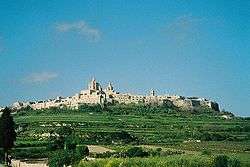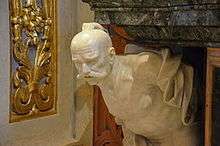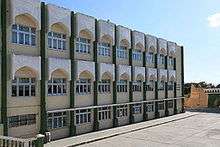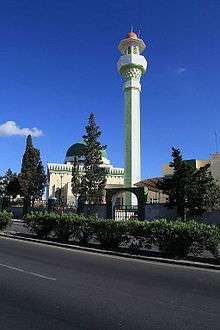Islam in Malta
Islam in Malta, although only recently being reintroduced in a sizeable number in the latter half of the 20th century, has had a historically profound impact upon the country—especially its language and agriculture—as a consequence of previous centuries of Muslim control and presence on its islands. Today, the main organizations represented in Malta are the Libyan World Islamic Call Society and the minority Ahmadiyya.[1]
History
Byzantine rule: 533-869
Prior to Muslim rule, Eastern Christianity had been prominent in Malta during the time of Greek-Byzantine rule and even remained significant during the Islamic period.[2][3]
Muslim rule: 870-1090

Islam is believed to have been introduced to Malta when the North African Aghlabids, first led by Halaf al-Hadim and later by Sawada ibn Muhammad,[4] conquered the islands from the Byzantines, after arriving from Sicily in 870[5] (as part of the wider Arab–Byzantine wars).[6] However, it has also been argued that the islands were occupied by Muslims earlier in the 9th, and possibly 8th, century.[7] The Aghlabids established their capital in Mdina.[8] The old Roman fortification, later to become Fort St Angelo, was also extended.[9]
According to the Arab chronicler and geographer Muhammad bin Abd al-Munim al-Himyari (author of Kitab al-Rawd al-Mitar), following the Muslim attack and conquest, Malta was practically uninhabited until it was recolonised by Muslims from Sicily in 1048–1049, or possibly several decades earlier.[4]
The Muslims generally tolerated the Christian population of Malta.[10]
Medieval Period: 1091-1224
Malta returned to Christian European rule with the Norman conquest in 1091. It was, with Noto on the southern tip of Sicily, the last Arab stronghold in the region to be retaken by the resurgent Christians.[11]
The Arab administration was initially kept in place[12] and Muslims were allowed to practise their religion freely until the 13th century.[13] The Normans allowed an emir to remain in power with the understanding that he would pay an annual tribute to them in mules, horses, and munitions.[14] As a result of this favourable environment, Muslims continued to demographically and economically dominate Malta for at least another 150 years after the Christian conquest.[15]
In 1122 Malta experienced a Muslim uprising and in 1127 Roger II of Sicily reconquered the islands.[16]
Even in 1175, Burchard, bishop of Strasbourg, an envoy of Frederick I, Holy Roman Emperor, had the impression, based upon his brief visit to Malta, that it was exclusively or mainly inhabited by Muslims.[17]
In 1224, Frederick II, Holy Roman Emperor, sent an expedition against Malta to establish royal control and prevent its Muslim population from helping a Muslim rebellion in the Kingdom of Sicily.[18]
The conquest of the Normans would lead to the gradual Latinization and subsequent firm establishment of Roman Catholicism in Malta, after previous respective Eastern Orthodox and Islamic domination.[2][3]
1225-1529
According to a report in 1240 or 1241 by Gililberto Abbate, who was the royal governor of Frederick II of Sicily during the Genoese Period of the County of Malta,[19] in that year the islands of Malta and Gozo had 836 Muslim families, 250 Christian families and 33 Jewish families.[20]
In 1266, Malta was turned over in fiefdom to Charles of Anjou, brother of France’s King Louis IX, who retained it in ownership until 1283. Eventually, during Charles's rule religious coexistence became precarious in Malta, since he had a genuine intolerance of religions other than Roman Catholicism.[21] However, Malta's links with Africa would still remain strong until the beginning of Spanish rule in 1283.[22]
By the end of the 15th century all Maltese Muslims would be forced to convert to Christianity and had to find ways to disguise their previous identities.[23] Notwithstanding the claim in this latter statement (attributed to the author Stefan Goodwin), Professor Godfrey Wettinger, who specialized in Malta's medieval history and whose work is used to support the claim, writes that the medieval Arab historian, Ibn Khaldun (1332—1406), puts the expulsion of Islam from Malta to the year 1249. Wettinger goes on to say that "there is no doubt that by the beginning of Angevin times [i.e. shortly after 1249] no professed Muslim Maltese remained either as free persons or even as serfs on the island."[24]
Knights of St. John: 1530-1798


During the period of rule under the Knights Hospitaller, thousands of Muslim slaves, captured as a result of maritime raids,[19] were taken to Malta.[25] In the mid-18th century, there were around 9000 Muslim slaves in Hospitaller-ruled Malta.[26] They were given a substantial amount of freedom, being allowed to gather for prayers.[27] Although there were laws preventing them from interacting with the Maltese people, these were not regularly enforced. Some slaves also worked as merchants, and at times were allowed to sell their wares in the streets and squares of Valletta.[28] A mosque was built in 1702 during the Order of St John[29] for Turkish slaves[30] within a prison building[31] of which neither ruins nor description of its architecture now remain. After the failure of the Conspiracy of the Slaves (1749), laws restricting the movement of slaves were made stricter. They could not go outside the city limits, and were not to approach any fortifications. They were not allowed to gather anywhere except from their mosque, and were to sleep only in the slave prisons. Moreover, they could not carry any weapons or keys of government buildings.[32]
There was also a deliberate and ultimately successful campaign, using disinformation and often led by the Roman Catholic clergy, to de-emphasize Malta's historic links with Africa and Islam.[33] This distorted history "determined the course of Maltese historiography till the second half of the twentieth century",[34] and it created the rampant Islamophobia which has traditionally been a feature of Malta (as of other southern European states).[35]
20th to 21st century

In 2003, of the estimated 3,000 Muslims in Malta, approximately 2,250 were foreigners, approximately 600 were naturalised citizens, and approximately 150 were native-born Maltese[36]—most notably Mario Farrugia Borg, who is part of the personal secretariat of Prime Minister Joseph Muscat[37] and was the first Maltese public officer to take an oath on the Koran when co-opted into the Qormi local council in 1998.[38] By 2010, there were approximately 6,000 Muslims in Malta—most of whom are Sunni and foreigners.[39][lower-alpha 1]
There is one mosque called the Islamic Centre of Paola in Paola,[40] founded in 1978 by the World Islamic Call Society, and one adjoining Muslim school called the Maryam al-Batool school.[41]
Impact
The strongest legacy of Islam in Malta is the Maltese language,[41] and most place names (other than the names Malta and Gozo[42]) are Arabic, as are most surnames, e.g. Borg, Cassar, Chetcuti, Farrugia, Fenech, Micallef, Mifsud and Zammit.[43][44] It has been argued that this survival of the Maltese language, as opposed to the extinction of Siculo-Arabic in Sicily, is probably due to the eventual large-scale conversions to Christianity of the proportionally large Maltese Muslim population.[45]
The Muslims also introduced innovative and skillful irrigation techniques such as the water-wheel known as the Noria or Sienja,[46] all of which made Malta more fertile.[47] They also introduced sweet pastries and spices and new crops, including citrus, figs, almond,[9] as well as the cultivation of the cotton plant, which would become the mainstay of the Maltese economy for several centuries,[48] until the latter stages of the rule of the Knights of St. John.[46] The distinctive landscape of terraced fields is also the result of introduced ancient Arab methods.[9]
The Catholic religious traditions of the Maltese were also impacted by the Muslim presence.[49]
In modern times, Malta's unique culture has enabled it to serve as Europe's "bridge" to the Arab cultures and economies of North Africa.[50]
See also
| Wikimedia Commons has media related to Islam in Malta. |
- History of Malta
- History of Islam in southern Italy
- Siege of Malta (1429)
- Invasion of Gozo (1551)
- Great Siege of Malta
Notes
References
- ↑ Jørgen S. Nielsen; Jørgen Nielsen; Samim Akgönül; Ahmet Alibasi; Egdunas Racius. Yearbook of Muslims in Europe, Volume 4. pp. 390–391. ISBN 978-90-04-22521-3. Retrieved June 25, 2014.
- 1 2 Kenneth M. Setton, "The Byzantine Background to the Italian Renaissance" in Proceedings of the American Philosophical Society, 100:1 (Feb. 24, 1956), pp. 1–76.
- 1 2 Daftary, Farhad. The Ismāʻı̄lı̄s: Their History and Doctrines. Cambridge University Press. ISBN 0-521-37019-1.
- 1 2 Travel Malta. The Arab period and the Middle Ages: MobileReference. ISBN 9781611982794.
- ↑ Christian W. Troll; C.T.R. Hewer (12 Sep 2012). "Journeying toward God". Christian Lives Given to the Study of Islam. Fordham Univ Press. p. 258. ISBN 9780823243198.
- ↑ David W. Tschanz (October 2011). "Malta and the Arabs". p. 4. Retrieved 1 June 2014.
- ↑ Martijn Theodoor Houtsma (1993). E.J. Brill's First Encyclopaedia of Islam, 1913-1936 (reprint (volume 5) ed.). BRILL. p. 213. ISBN 9789004097919.
- ↑ Simon Gaul (2007). Malta, Gozo and Comino (illustrated ed.). New Holland Publishers. p. 236. ISBN 9781860113659.
- 1 2 3 "Arab Legacy - Arab Rule in Malta". Malta Tourism Authority. Retrieved 10 May 2014.
- ↑ Neil Wilson; Carolyn Joy Bain (2010). "History". Malta and Gozo (illustrated ed.). Lonely Planet. p. 18. ISBN 9781741045086.
- ↑ Previté-Orton (1971), pg. 507-11
- ↑ Krueger, Hilmar C. (1969). "Conflict in the Mediterranean before the First Crusade: B. The Italian Cities and the Arabs before 1095". In Baldwin, M. W. A History of the Crusades, vol. I: The First Hundred Years. Madison: University of Wisconsin Press. pp. 40–53.
- ↑ Arab Heritage in Malta | The Baheyeldin Dynasty
- ↑ Stefan Goodwin (1 Jan 2002). "2 (Islam and Realignments)". Malta, Mediterranean Bridge (illustrated ed.). Greenwood Publishing Group. p. 23. ISBN 9780897898201.
- ↑ Stefan Goodwin (1 Jan 2002). "2 (Islam and Realignments)". Malta, Mediterranean Bridge (illustrated ed.). Greenwood Publishing Group. p. 31. ISBN 9780897898201.
Of greater cultural significance, the demographic and economic dominance of Muslims continued for at least another century and a half after which forced conversions undoubtedly permitted many former Muslims to remain.
- ↑ Uwe Jens Rudolf; Warren G. Berg (27 Apr 2010). "Chronology". Historical Dictionary of Malta (2 (illustrated) ed.). Scarecrow Press. p. xxviii. ISBN 9780810873902.
- ↑ Graham A. Loud; Alex Metcalfe (1 Jan 2002). "Religious Toleration in the South Italian Peninsula". The Society of Norman Italy (illustrated ed.). BRILL. p. 337. ISBN 9789004125414.
- ↑ Charles Dalli. From Islam to Christianity: the Case of Sicily (PDF). p. 161. Retrieved 9 May 2014.
- 1 2 3 Martin R. Zammit (12 Oct 2012). Jørgen S. Nielsen; Jørgen Nielsen; Samim Akgönül; Ahmet Alibasi; Egdunas Racius, eds. Yearbook of Muslims in Europe, Volume 4. Malta: BRILL. p. 389. ISBN 9789004225213.
- ↑ Stefan Goodwin (1 Jan 2002). "2 (Islam and Realignments)". Malta, Mediterranean Bridge (illustrated ed.). Greenwood Publishing Group. p. 28. ISBN 9780897898201.
The establishment of an Italian colony for Sicilian Muslims at Lucera on the Italian Peninsula beginning in 1223 has led to much speculation that there must have been a general expulsion of all Muslims from Malta in 1224. However, it is virtually impossible to reconcile this viewpoint with a report of 1240 or 1241 by Gilibert to Frederick II of Sicily to the effect that in that year Malta and Gozo had 836 families that were Saracen or Muslim, 250 that were Christian, and 33 that were Jewish. Moreover, Ibn Khaldun is on record as stating that some Maltese Muslims were sent to the Italian colony of Lucera around 1249.
- ↑ Stefan Goodwin (1 Jan 2002). "2 (Islam and Realignments)". Malta, Mediterranean Bridge (illustrated ed.). Greenwood Publishing Group. p. 30. ISBN 9780897898201.
- ↑ Stefan Goodwin (1 Jan 2002). "2 (Islam and Realignments)". Malta, Mediterranean Bridge (illustrated ed.). Greenwood Publishing Group. p. 31. ISBN 9780897898201.
- ↑ Stefan Goodwin (1 Jan 2002). "2 (Islam and Realignments)". Malta, Mediterranean Bridge (illustrated ed.). Greenwood Publishing Group. p. 24. ISBN 9780897898201.
Though by the end of the fifteenth century all Maltese Muslims would be forced to convert to Christianity, they would still be in the process of acquiring surnames as required in European tradition. Ingeniously, they often used their father’s personal Arabic names as the basis of surnames, though there was a consistent cultural avoidance of extremely obvious Arabic and Muslim names, such as Muhammed and Razul. Also, many families disguised their Arabic names, such as Karwan (the city in Tunisia), which became Caruana, and some derived family names by translating from Arabic into a Roman form, such as Magro or Magri from Dejf.
- ↑ https://vassallohistory.wordpress.com/vassallo/the-origin-of-the-maltese-surnames/.
Ibn Khaldun puts the expulsion of Islam from the Maltese Islands to the year 1249. It is not clear what actually happened then, except that the Maltese language, derived from Arabic, certainly survived. Either the number of Christians was far larger than Giliberto had indicated, and they themselves already spoke Maltese, or a large proportion of the Muslims themselves accepted baptism and stayed behind. Henri Bresc has written that there are indications of further Muslim political activity on Malta during the last Suabian years. [2] Anyhow there is no doubt that by the beginning of Angevin times no professed Muslim Maltese remained either as free persons or even as serfs on the island.
External link in|title=(help) - ↑ Martijn Theodoor Houtsma (1993). E.J. Brill's First Encyclopaedia of Islam, 1913-1936 (reprint (volume 5) ed.). BRILL. p. 214. ISBN 9789004097919.
- ↑ Eltis, David; Bradley, Keith; Cartledge, Paul (2011). The Cambridge World History of Slavery: Volume 3: AD 1420-AD 1804. Cambridge University Press. p. 144. ISBN 9780521840682.
- ↑ Fisher, Humphrey J. (2001). Slavery in the History of Muslim Black Africa. London: C. Hurst & Co. Publishers. p. 31. ISBN 9781850655244.
- ↑ Goodwin, Stefan (2002). Malta, Mediterranean Bridge. Greenwood Publishing Group. p. 43. ISBN 9780897898201.
- ↑ Wettinger, Godfrey (2002), Slavery in the Islands of Malta and Gozo ca. 1000-1812, Publishers Enterprises Group, p. 455.
- ↑ A Tour Through Sicily and Malta.
- ↑ Wettinger, Godfrey (2002), in Cini, George, "Horrible torture on streets of Valletta".
- ↑ Sciberras, Sandro. "Maltese History - E. The Decline of the Order of St John In the 18th Century" (PDF). St. Benedict College. Archived from the original (PDF) on 26 June 2015.
- ↑ Stefan Goodwin (1 Jan 2002). "2 (Islam and Realignments)". Malta, Mediterranean Bridge (illustrated ed.). Greenwood Publishing Group. pp. 23–24. ISBN 9780897898201.
Gian Francesco Abela, a patrician clergyman who eventually became the Order’s [i.e., Knights Hospitaller's] vice-chancellor, also laid the foundations for Maltese historiography. Unfortunately, Abela was quite willing to distort Malta’s history in the interest of deemphasizing her historic links with Africa and with Islam. Abela’s determination that Malta be portrayed as innately European and Christian at all cost eventually incorporated into popular thinking about Malta’s history a number of false traditions. In an eighteenth-century effort to strengthen the case for Abela’s distortions and misinterpretations, a Maltese priest named Giuseppe Vella even generated forged Arabic documents.
Other prominent Maltese subsequently contributed to popular folklore and legends which held that Muslims of African origin had never inhabited Malta in large numbers, including Domenico Magri, also a priest. As these distortions bore fruit and circulated within the general populace, numerous Maltese became convinced that their Semitic tongue could only have come from illustrious and pioneering Asiatic Phoenicians and not under any circumstances from neighboring Arab-speaking Africans who for reasons having to do with religion, national pride, and “race” the Maltese were more comfortable viewing as implacable enemies and inferiors . . . . Though recent scholarly opinion in Malta is virtually unanimous that Malta’s linguistic and demographic connections are much stronger with her Arab and Berber neighbors than [with] prehistoric Phoenicia, once out of a “Pandora’s Box,” legends die hard.
- ↑ Mario Buhagiar. "POST MUSLIM MALTA - A CASE STUDY IN ARTISTIC AND ARCHITECTURAL CROSS-CURRENTS". Retrieved 1 June 2014.
The Muslim past became an embarrassment and history was distorted by false traditions which determined the course of Maltese historiography till the second half of the twentieth century.
- ↑ Carmel Borg; Peter Mayo (2007). "22 (Toward an Antiracist Agenda in Education: The Case of Malta)". In Gupta, Tania Das. Race and Racialization: Essential Readings. Canadian Scholars’ Press. p. 179. ISBN 9781551303352.
- ↑ "International Religious Freedom Report 2003 – Malta". Bureau of Democracy, Human Rights, and Labor, United States Department of State. Retrieved 9 January 2008.
- ↑ James Debono (8 December 2013). "A Muslim from Qormi: Mario Farrugia Borg". Mediatoday. MaltaToday. Retrieved 1 June 2014.
- ↑ Christian Peregin (7 February 2011). "Muslim and former PN councillor converts . . . to Labour". TIMES OF MALTA. Retrieved 1 June 2014.
- ↑ "International Religious Freedom Report 2011". 17 Nov 2010.
- ↑ Triq Kordin (2012). "Islamic Centre of Paola". Paola, Malta. Retrieved 8 May 2014.
This is Malta's only mosque. Also the home of the Mariam al-Batool school.
- 1 2 Christian W. Troll; C.T.R. Hewer (12 Sep 2012). "Journeying toward God". Christian Lives Given to the Study of Islam. Fordham Univ Press. p. 259. ISBN 9780823243198.
- ↑ Neil Wilson; Carolyn Joy Bain (2010). "History". Malta and Gozo (illustrated ed.). Lonely Planet. p. 18. ISBN 9781741045086.
Apart from the names Malta and Gozo, which probably have Latin roots, there is not a single place name in the Maltese Islands that can be proved to predate the Arab occupation.
- ↑ Kristina Chetcuti (9 February 2014). "Why most Maltese share the same 100 surnames". Times of Malta. Retrieved 12 May 2014.
- ↑ Juliet Rix (1 Apr 2013). "1 (History)". Malta (2, illustrated ed.). Bradt Travel Guides. p. 9. ISBN 9781841624525.
- ↑ Stefan Goodwin (1 Jan 2002). "2 (Islam and Realignments)". Malta, Mediterranean Bridge (illustrated ed.). Greenwood Publishing Group. p. 31. ISBN 9780897898201.
The likelihood that many Muslims in Malta eventually converted to Christianity rather than leave seems indicated by parallels in Sicily as well as by the fact that there is linguistic evidence suggesting that “there was a time when the church of Malta was fed by Christian Arabs.” Luttrell [Anthony T. Luttrell] is also on record with the argument that “the persistence of the spoken Arabo-Berber language” in Malta can probably best be explained by eventual large-scale conversions of Maltese Muslims to Christianity. Even when Islam had completely been erased from the Maltese landscape, Arabic remained, especially as represented by colloquial dialects of the language spoken in Libya, Tunisia, and in medieval Sicily.
In the words of Aquilina, “The Arabs are linguistically the most important people that ever managed the affairs of the country…for there is no doubt that, allowing for a number of peculiarities and erratic developments, Maltese is structurally an Arabic dialect.”
- 1 2 Victor Paul Borg (2001). Malta and Gozo (illustrated ed.). Rough Guides. p. 332. ISBN 9781858286808.
- ↑ Mario Buhagiar (2007). The Christianisation of Malta: catacombs, cult centres and churches in Malta to 1530 (illustrated ed.). Archaeopress. p. 83. ISBN 9781407301099.
- ↑ Aa. Vv. (2007). "Introduction". Malta. Ediz. Inglese. Casa Editrice Bonechi. pp. 6–7. ISBN 9788875512026.
- ↑ David Tschanz. "Malta and the Arabs". academia.edu. p.6.
- ↑ Uwe Jens Rudolf; Warren G. Berg (27 Apr 2010). "Introduction". Historical Dictionary of Malta (2 (illustrated) ed.). Scarecrow Press. pp. 3–4. ISBN 9780810873902.
Whether because of their closer proximity to Italy or strong loyalty to the pope in Rome, certainly since the arrival of the Knights, the Maltese people have considered themselves to be European. This makes it all the more remarkable that the linguistic legacy of the Arab invaders survived so many centuries of Italian and European influence so that even today, the devoutly Roman Catholic population appeals to God as "Allah." Only recently have the Maltese begun to leverage their country's ability to serve as Europe's "bridge" to Arab cultures and economies of North Africa.
Further reading
- "The Arabs in Malta" (various publications by different authors on Islam in Malta).
Note: The following contributions to the history of the Arabs in Malta are arranged in chronological order of publication.
- Stefan Goodwin (1 Jan 2002). "Chapter 2 (Islam and Realignments)". Malta, Mediterranean Bridge (illustrated ed.). Greenwood Publishing Group. pp. 13–35. ISBN 9780897898201.
- Martin R. Zammit (12 Oct 2012). Jørgen S. Nielsen; Jørgen Nielsen; Samim Akgönül; Ahmet Alibasi; Egdunas Racius, eds. Yearbook of Muslims in Europe, Volume 4. Malta: BRILL. pp. 389–397. ISBN 9789004225213.

